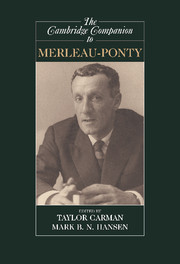Book contents
- Frontmatter
- Introduction
- 1 Merleau-Ponty and the Epistemological Picture
- 2 Sensation, Judgment, and the Phenomenal Field
- 3 Seeing Things in Merleau-Ponty
- 4 Motives, Reasons, and Causes
- 5 Merleau-Ponty and Recent Cognitive Science
- 6 The Silent, Limping Body of Philosophy
- 7 Merleau-Ponty and the Touch of Malebranche
- 8 A Phenomenology of Life
- 9 The Embryology of the (In)visible
- 10 Merleau-Ponty’s Existential Conception of Science
- 11 Between Philosophy and Art
- 12 Understanding the Engaged Philosopher: On Politics, Philosophy, and Art
- 13 Thinking Politics
- References
- Index
1 - Merleau-Ponty and the Epistemological Picture
Published online by Cambridge University Press: 28 May 2006
- Frontmatter
- Introduction
- 1 Merleau-Ponty and the Epistemological Picture
- 2 Sensation, Judgment, and the Phenomenal Field
- 3 Seeing Things in Merleau-Ponty
- 4 Motives, Reasons, and Causes
- 5 Merleau-Ponty and Recent Cognitive Science
- 6 The Silent, Limping Body of Philosophy
- 7 Merleau-Ponty and the Touch of Malebranche
- 8 A Phenomenology of Life
- 9 The Embryology of the (In)visible
- 10 Merleau-Ponty’s Existential Conception of Science
- 11 Between Philosophy and Art
- 12 Understanding the Engaged Philosopher: On Politics, Philosophy, and Art
- 13 Thinking Politics
- References
- Index
Summary
Ein Bild hielt uns gefangen.
WittgensteinSe demander si le monde est réel, c'est ne pas entendre ce qu'on dit.
Merleau-PontyThe second saying, by Merleau-Ponty, represents the culmination of an argument whose effect was to undo the state of thraldomdescribed in the first saying, taken from the Philosophical Investigations of Wittgenstein.
The picture that held us captive was that of a mediational epistemology. I mean by that an understanding of the place of mind in a world such that our only knowledge of reality comes through the representations we have formed of it within ourselves. The initial statement of this structuring picture is found in Descartes, who at one point declares himself “certain that I can have no knowledge of what is outside me except by means of the ideas I have within me” (assuré que je ne puis avoir aucune connaissance de ce qui est hors de moi, que par l'entremise des idées que j'en ai eues en moi). This picture sets up a certain distinction between inside and outside (we can call it the I/O picture), which continues to reverberate through the tradition. The basic idea of a mediational epistemology is expressed by the preposition “through” (par l’interm´ediaire de, in this Cartesian formulation).We grasp the world through something, what is outside through something inner.
- Type
- Chapter
- Information
- The Cambridge Companion to Merleau-Ponty , pp. 26 - 49Publisher: Cambridge University PressPrint publication year: 2004
- 9
- Cited by

